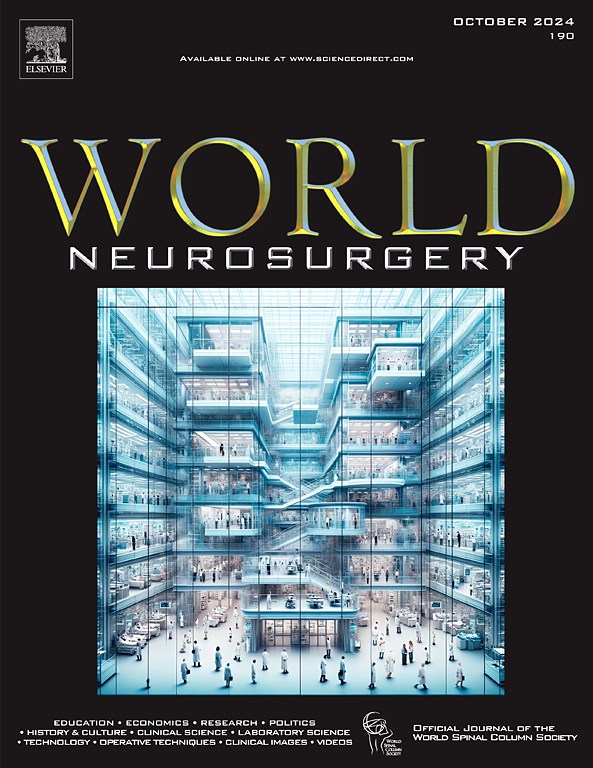急性重症脊髓损伤腰脑脊液引流加鞘内压力监测的安全性和可行性:一项随机先导试验。
IF 2.1
4区 医学
Q3 CLINICAL NEUROLOGY
引用次数: 0
摘要
背景:脊髓灌注损伤是急性脊髓损伤(SCI)的重要继发机制。虽然腰椎脑脊液(CSF)引流术广泛应用于心胸外科,但其在脊髓损伤中的应用仍然有限。本研究评估了急性脊髓损伤患者在鞘内压(ITP)和脊髓灌注压(SCPP)监测下腰椎脑脊液引流的安全性和可行性。方法:我们进行了一项前瞻性随机试验,涉及21例急性创伤性脊髓损伤(ASIA a - c)。12例患者接受连续腰椎CSF引流和SCPP监测超过72小时,而9例患者接受标准治疗。衡量的主要结果是12个月时亚洲得分的变化。次要结局包括ITP测量、MAP要求、可行性和安全性数据。结果:引流组初始ITP平均为15 mmHg,经控制引流后降至6 mmHg。与对照组相比,该组维持较低的map(74对82 mmHg, p = 0.004),并且需要较少的血管加压剂支持。神经学方面,引流组4例患者改善至ASIA C或D,对照组1例。引流组的平均运动评分改善更大(Δ11 vs. Δ7),尽管差异无统计学意义。无引流相关并发症发生。结论:腰椎脑脊液引流是一种安全可行的治疗急性脊髓损伤的干预措施,可实现量身定制的灌注管理。虽然初步研究结果很有希望,但需要更大规模的多中心试验来验证其临床疗效并确定最佳的SCPP靶点。本文章由计算机程序翻译,如有差异,请以英文原文为准。
Safety and Feasibility of Lumbar Cerebrospinal Fluid Drainage with Intrathecal Pressure Monitoring in Acute Severe Spinal Cord Injury: A Randomized Pilot Trial
Background
Spinal cord perfusion impairment is a critical secondary mechanism in acute spinal cord injury (SCI). Although lumbar cerebrospinal fluid (CSF) drainage is widely used in cardiothoracic surgery, its use in SCI remains limited. This study presents an evaluation of the safety and feasibility of lumbar CSF drainage with intrathecal pressure (ITP) and spinal cord perfusion pressure (SCPP) monitoring in acute SCI patients.
Methods
We conducted a prospective randomized pilot trial involving 21 patients with acute traumatic SCI (American Spinal Injury Association [ASIA] A–C). Twelve patients received continuous lumbar CSF drainage and SCPP monitoring over 72 hours, whereas 9 received standard care. The primary outcome measured was the change in ASIA scores at 12 months. The secondary outcomes included ITP measurements, mean arterial pressure requirements, and feasibility and safety data.
Results
The initial ITP in the drainage group averaged 15 mmHg and was reduced to 6 mmHg via controlled drainage. This group maintained lower mean arterial pressures (74 vs. 82 mmHg, P = 0.004) compared to the control group and required less vasopressor support. Neurologically, 4 patients in the drainage group improved to ASIA C or D, compared to 1 patient in the control group. The mean motor score improvement was greater in the drainage group (Δ11 vs. Δ7), although the difference was not statistically significant. No drainage-related complications occurred.
Conclusions
Lumbar CSF drainage is a safe and feasible intervention for the treatment of acute SCI, enabling tailored perfusion management. Although preliminary findings are promising, larger multicenter trials are needed to validate their clinical efficacy and define optimal SCPP targets.
求助全文
通过发布文献求助,成功后即可免费获取论文全文。
去求助
来源期刊

World neurosurgery
CLINICAL NEUROLOGY-SURGERY
CiteScore
3.90
自引率
15.00%
发文量
1765
审稿时长
47 days
期刊介绍:
World Neurosurgery has an open access mirror journal World Neurosurgery: X, sharing the same aims and scope, editorial team, submission system and rigorous peer review.
The journal''s mission is to:
-To provide a first-class international forum and a 2-way conduit for dialogue that is relevant to neurosurgeons and providers who care for neurosurgery patients. The categories of the exchanged information include clinical and basic science, as well as global information that provide social, political, educational, economic, cultural or societal insights and knowledge that are of significance and relevance to worldwide neurosurgery patient care.
-To act as a primary intellectual catalyst for the stimulation of creativity, the creation of new knowledge, and the enhancement of quality neurosurgical care worldwide.
-To provide a forum for communication that enriches the lives of all neurosurgeons and their colleagues; and, in so doing, enriches the lives of their patients.
Topics to be addressed in World Neurosurgery include: EDUCATION, ECONOMICS, RESEARCH, POLITICS, HISTORY, CULTURE, CLINICAL SCIENCE, LABORATORY SCIENCE, TECHNOLOGY, OPERATIVE TECHNIQUES, CLINICAL IMAGES, VIDEOS
 求助内容:
求助内容: 应助结果提醒方式:
应助结果提醒方式:


